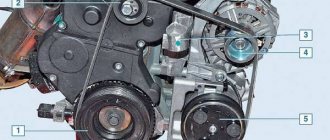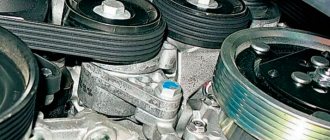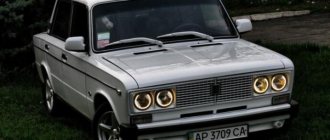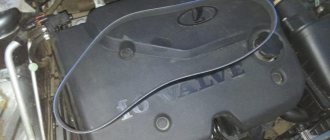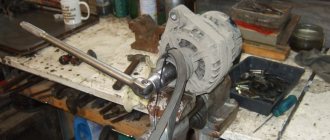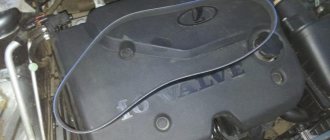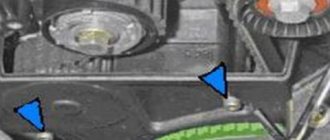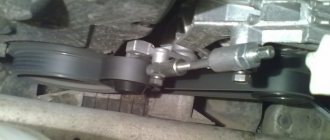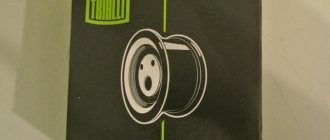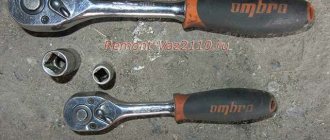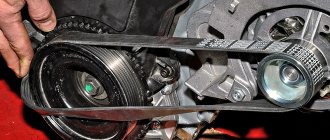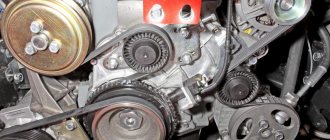The alternator belt on the Lada Priora drives all attachments. And since there were many configurations with different combinations of units, there were also several belt options: for cars without additional equipment, versions with air conditioning and power steering, or cars with one additional unit.
Note that in practice, alternator belts for Priora are often selected not according to codes, but according to sizes and recommendations - this is simply a method that has already been proven by the experience of other car owners and has proven its effectiveness.
Preface
Every car owner has encountered such a problem as creaking and slipping of the alternator belt when turning on the headlights, air conditioning, or when driving the car in wet weather. In most cases, to solve this problem, you just need to tighten the belt and everything will fall into place, the creaking and slipping will disappear.
There are times when tightening does not help and the belt has to be replaced, and then Prior owners have a question: what size belt is installed on my car?
The alternator belt in a Lada Priora car can be made in several sizes depending on the vehicle configuration.
In this article we will talk about alternator belts for the Lada Priora car. Below we talk in detail about belt sizes, their manufacturers that you can easily trust, and of course about the process of replacing the alternator belt.
Belt sizes
The Priora is equipped with a poly-V-ribbed alternator belt of various sizes depending on the vehicle configuration. The more additional equipment installed on the vehicle, the longer the belt will be.
Below is a table with the dimensions of the Lada Priora alternator belt.
| Add. equipment | Belt number | Length , (mm) | Note |
| With power steering | 6PK1115 | 1115 | |
| With Panasonic air conditioner | 6PK1125 | 1125 | Different from Halla belt |
| Without power steering and without air conditioning | 6PK742 | 742 | Belt from VAZ 2110 |
| With Halla air conditioning | 6PK1115 | 1115 | Different from Panasonic belt |
| With air conditioning and power steering | 6PK1420 | 1420 |
The differences in alternator belts in Priors with air conditioning are due to the fact that they have different mountings for the air conditioning pumps, which significantly affected the size of the belt itself.
How to understand which air conditioner is installed in your car, read more in our article here.
The best alternator belts for Priora
The service life of the alternator belt on a Lada Priora car reaches 60,000 km, but quite often after replacing the belt it begins to whistle. After tightening, the whistle goes away, but appears again until the tension roller can no longer tighten the belt. This is due to the fact that the car uses a low-quality belt.
The table below shows the best and highest quality alternator belts.
Price and dimensions of the Priora generator frames
| Manufacturer | Size | Price, (rubles) |
| Gates | 742, 1115, 1125 | 400-800 |
| Dayco | 742, 1115, 1125 | 600-800 |
| Luzar | 742, 1115, 1125, 1420 | 350-700 |
| Lada | 742, 1115, 1125, 1420 | 500-800 |
Generator characteristics
The VAZ 2170, or Lada Priora, is equipped with a classic alternating current device, supplemented by a diode bridge for rectifying electricity and a voltage regulator. Works in parallel with the battery in all modifications of Lada Priora with engines operated at temperatures from -40 to +45 degrees.
The Priora factory generator 5102.3771 is produced by the Russian brand “Pramo”.
Its main feature is the increased current output parameters at low speeds (at 300 rpm up to 6 Amperes). Undoubtedly, this is a significant advantage, especially when operating a car in winter at subzero temperatures. Moreover, the use of such a unit allows the use of an automatic transmission.
Generator device
The standard Priora device has the following characteristics:
- weight 5410 grams;
- gear ratio 1/2.4;
- power 205 watts;
- current strength at maximum values 80 Amperes;
- voltage range 13.8–14.4 V.
The peculiarity of the generator connection involves power supply using the fuse box, which means that the chain then leads to the battery and the ignition switch. The generator is also connected to a lamp indicating low battery. When the propulsion system starts, power is supplied to the device winding through three diodes of the rectifier unit. The correct operation can be easily monitored by the lamp indication. When the ignition key is turned to the first position, the warning light lights up on the instrument panel. The engine starts - it goes out (if the generator is working). If the lamp is on, the device has obvious problems.
Structurally, the generator consists of a drive pulley, bearings, covers, tie rods, rotor and stator, rectifier unit and voltage regulator. The rotor is the moving part of the device; it rotates on bearings installed in the covers at the front and rear. As the rotor rotates, the brushes rub against the contacts. The alternating current thus generated passes through the diode bridge (rectifier unit), where it is transformed into direct current.
Differences in the design of the generator of different modifications
Non-interchangeable generators are often installed on the Lada Priora. This is due to the presence of additional equipment (air conditioning, power steering). This is reflected in the difference in fastenings. In addition, a special roller can be used to tension the belt.
On Priors with engines 21116 and 21126, the tension pulley is not used.
To protect the on-board network from voltage surges, a capacitor is provided with a capacity of 2.2 μF. It is located on the rectifier block. The capacitor is also used to eliminate interference between the positive and ground of the generator.
Signs of belt replacement
Signs for which it is recommended to replace the alternator belt are presented in the list below. It is not recommended to go on a long journey, for example at sea in the summer, with an already worn-out belt, since replacing the alternator belt on a Priora in the field is quite problematic.
List of signs:
- Belt whistle;
- Cuts and cracks;
- Delamination;
- Dryness;
- Sticking threads are visible;
If such factors exist on your belt, it is advisable to replace it soon.
Generator malfunctions and ways to eliminate them
There aren't many problems. They come in two main varieties.
| Type of faults | Signs |
| Mechanical. | First of all, these are mechanical damage to the housing, fasteners, wear of bearings, graphite brushes, overrunning clutch or pulley. |
| Electrical faults. | They consist of a short circuit on the rotor or stator windings, failure of the rectifier unit, voltage regulator, etc. The fact that the generator may soon fail is indicated by characteristic signs associated with difficulty starting the engine, dim headlights. Problems are also indicated by a warning light on the instrument panel that does not go out when the engine starts. |
The generator and battery always work together. For the battery, the generator is the only autonomous power source, which allows it to remain as a backup power source for the on-board network when the generator is not working. In turn, by constantly recharging the battery, the generator makes it possible to start the engine at any time.
Generator malfunctions do not occur out of nowhere; there are usually preconditions for breakdowns. And the owner has the opportunity to correct the malfunction in a timely manner. Otherwise, the generator will need to be repaired on Priora.
Difficulty starting the engine
Problems with starting the propulsion system directly indicate problems with the generator. If it malfunctions, the battery experiences a constant lack of charge, which means it does not have enough power to rotate the engine flywheel through the starter. A discharged battery is the main result of a generator breakdown. A malfunction of this device can result not only from a lack of charge, but also, conversely, from overcharging. Such phenomena arise due to the failure of the relay regulator, i.e., current is generated in much larger volumes. This leads to boiling of the electrolyte in the battery banks and, as a consequence, to failure of the battery.
Headlights are dim or flickering
The second main sign of malfunction is easy to notice in the dark. As a rule, as the load on the on-board network increases, the brightness of the headlights decreases significantly. Such a symptom may indicate a breakdown of both the device itself and its drive belt (the tension should be checked). A decrease in brightness is observed not only in the headlights, but also in the dashboard lighting.
The control lamp is constantly on
If it works on the panel all the time, this can only indicate that the battery is not receiving sufficient charge. Thus, the on-board computer warns that the car will not start at all soon. In other words, the on-board network uses a battery rather than a generator as the main power source. In this situation, after just a few kilometers the battery will be completely discharged and the engine will stall, since the spark plugs will no longer be able to produce a spark.
If such a problem occurs, first of all you need to turn off as many energy consumers as possible (headlights, audio system, heating, etc.). And try to get to the nearest car service center. Otherwise, you will have to turn off the engine and call a tow truck.
Some modern batteries may become unusable after the first full discharge, which means that the services of a tow truck will save money.
Drive belt whistle
Often when starting the engine, especially in the cold, it starts to whistle. This sound occurs because the generator drive belt is too loose and simply slips. In this case, you need to tighten the belt as quickly as possible, eliminating the malfunction.
Ignoring the whistle leads to the fact that insufficient rotation speed of the pulley due to slipping causes a voltage drop, since the generator does not generate the necessary electricity. This is especially true on simple engines without additional equipment. As a rule, on power plants with power steering and air conditioning, a special roller is used to automatically tighten the strap.
Belt damage
If smoke and a characteristic smell of burnt rubber appear in the area where the generator is located, it means that some drive begins to jam, as a result of which the generator belt on a Priora with air conditioning heats up and peels off. In some cases, a broken belt not only causes the generator set to stop, but can also cause a malfunction of the gas distribution mechanism if pieces of rubber get under the timing rollers or pulleys. Overheating and destruction of the belt may also indicate wear of the bearings; they should rotate freely.
Ringing and other extraneous sounds when the generator is running
The device is equipped with rolling bearings. Their operating conditions involve elevated temperatures and heavy loads, which leads to a decrease in their service life. With use, these devices begin to wear out, and their lubricant burns out. As a result, the lack of the proper amount of lubrication leads to the appearance of characteristic sounds of worn-out bearings. Operating a generator with such symptoms usually ends in the destruction of the bearings and failure of the entire assembly.
The overrunning clutch may also make noise. As it wears out, it begins to deform and can no longer perform its normal functions. In any case, to troubleshoot problems, you should remove and disassemble the device, replacing damaged elements.
A special electric hum
When the motor winding closes, a sound arises that cannot be confused with another. When it occurs, it is easily identified even by a beginner. In this case, the easiest way is to change the generator assembly or find a stator or rotor from the same device.
You should not go on long trips with a problem unit. Failure of the device can cause the engine to stop completely and require outside assistance. Without tools, spare parts and other necessary materials, it is impossible to solve the problem on site. Especially if in most cases the battery is completely discharged. To avoid this, you should regularly inspect the generator and identify even the slightest malfunctions in time.
It is recommended to remove the assembly every 80,000–100,000 kilometers and completely disassemble it for troubleshooting and inspection.
Replacement process
- Unscrew the generator belt tension roller with a 17 mm wrench;
- Loosen the generator mounts with a 13mm wrench;
- We unscrew the mount of the engine mount to the body using the E10 head;
- We jack up the car and remove the wheel;
- We rest the log against the crankcase and lower the jack a little so that a small gap appears between the support and the body, into which it is necessary to squeeze a new belt, after first dismantling the old belt;
- We raise the jack again, remove the log, install the wheel and reassemble in the reverse order
Step-by-step instructions for replacing without power steering
Do-it-yourself replacement work on a Priora without power steering (EUR) and air conditioning is more convenient to carry out in the inspection pit.
Tools
- a set of keys;
- fender liner removal device;
- balloon wrench.
Stages
- First, loosen the nut with a wrench of the appropriate size.
- Unscrew the adjusting bolt.
- We move the generator towards the power plant.
- Remove the right front wheel.
- We remove the fender liner and get access to the old belt.
- We replace it with a new one and do not forget to tighten it.
- Checking the tension. It should not be weak, but tightening it on a model with power steering (EUR) is also dangerous. The generator bearings may be the first to suffer.
Nut that needs to be loosened
Unscrew the bolt
We install a new one
